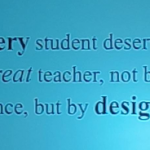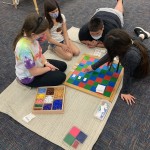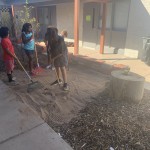This year, I made the decision to stop playing around and start making Spanish my second language. I currently teach grades 4-5 and my motivator was watching my Spanish speaking students work harder than their peers due to language barriers. I thought it only fair that I, as their teacher, do what I can to meet them halfway. I also believe that the simplest route between two locations is a straight line. In my teacher world, that means that the simplest way to help Spanish speaking students learn English based content is to give them a highly qualified, bilingual teacher. Spanish is the 2nd (maybe unofficial first) language of the United States. It is in my best interest to know it. Lastly, it’s simply beautiful and I am proud to speak it as much as I can.
Many Moments of Understanding
To begin with, I must let you know that I am way more excited to converse in Spanish with my Spanish speaking students. I am only at the intermediate conversation level. Therefore, my students are significantly better than I am, of course, so they are the “expert” and I look to them for correction. They really enjoy that I have noticed they are more willing to speak in Spanish more often in class. I did have to let them know, in Spanish, that I understand more than I can say and I did not appreciate the little jokes and limit testing they tried a few times. Once they knew I was on to them, they did not do that again. It was all healthy and age appropriate and I enjoyed seeing them being their relaxed selves in their native tongue. Once that was out of the way, I began to make some discoveries that helped me understand their situation better. The two that will be highlighted here spotlights contractions and pronouns.
No Contractions in Spanish
The Spanish language does not use contractions. Spanish uses pronouns to help shorten sentences and this is a whole area of study in itself. I was surprised to learn this. Not having this exposure in their native language explained why several of my Spanish speaking student struggled with contractions. Learning this helped me change my teaching approach for this content and give explicit instruction in this area for these students. The irony is that after learning contractions, they are then discouraged from using them in formal writing. Contractions may not seem like a big deal, but they represent many of the nuances between the languages that create barriers for English Language Learners.
Mastering Pronoun Usage is an Important Part of Fluent Spanish Dialogue
Based on my current instruction and conversations, I have learned that like in English it is expected for the communicator to get to the point as quickly as possible. Adding unnecessary words is not encouraged. Instead, pronouns are used to reference subjects previously identified. For my students, this showed up in their work as what I called minimalist writing. They used many pronouns and shortened the communication as often as possible. This was the opposite of what I was asking them to do: stretch your sentences out with as much detail and information as possible. When I told my 4th graders I am expecting at least 12 – 15 word sentences with rich and impactful vocabulary, they looked at me like “Why?” Now I understand. In fact, just learning the proper use of pronouns in Spanish is complex and I am still learning. The speaker must understand the context, the relationships, correct pronoun choice, the sentence structure, person vs. object, subject/object “gender” and plurality…and more! It’s not easy. I have my students help me with proper pronoun usage. Participating in my learning process helps them appreciate their own skills. They understand that mastering a language is complicated and takes practice. They know that language fluency involves more than knowing words. It includes the application of critical reading and thinking skills. In turn, when I am working with them on their English communication skills, they are more curious about sentence structure, order, grammar, and word choice. They are coming to appreciate the beauty of studying and learning a second language.
Functional VS. Fluent and Overall Language Skills
I have been aggressively studying Spanish conversation since August 2022. I am blessed to have several Spanish speaking students and many support staff workers that speak Spanish. Interestingly, I have learned that my students are not as advanced in Spanish as I assumed they are because I heard them speaking in Spanish every day. Conversing with them in Spanish has shown me that their vocabulary was limited and they often could not vocalize critical reading and language skills in Spanish. I also learned that none of my students wrote or read in Spanish and they were not aware of most Spanish spelling rules (for example /ll/ has two ls and /rr/ has two rs). Often, when I wrote sentences in Spanish on the board, they were surprised to see the actual word and said it looked different from how they heard it. In contrast, the adult support workers are very clear and strong in all levels of their communication. They model the correct structure, spelling, context, grammar, etc. They explain the logic behind why a certain word choice is better or why a certain word is pronounced a certain way in a certain context.
This made me think about why things were so different between the two groups? I am aware that in Arizona, for many years, Spanish speaking students were punished for speaking Spanish at school. In addition to this, their parents wanted to them assimilate into American culture. They often discouraged Spanish speaking and often insisted on English only for their children even if it meant that they could not communicate with each other. These children grew up to be the parents and grandparents of the children I am now teaching. In contrast, the adult Spanish speakers at my school grew up in Spanish only or bilingual schools. They were taught how to read, write, and speak in Spanish first, and then in English. They received a total language experience, have a rich Spanish vocabulary, and are masters at applying critical communication skills.
This is not the case for my students. I have observed that although they live in Spanish speaking homes and communities, my students are able to speak Spanish at a functional level, which is about a 3rd – 5th grade level. They have a limited Spanish vocabulary with no Spanish reading and writing experience. I have also noticed that this is similar to their English language arts skill. Lastly, our data shows that they began to struggle the most in English language reading and writing (ELA) starting around 4th grade. At this grade level, ELA does not focus on teaching how to read. It is about applying critical reading and comprehension skills with increasing vocabulary expectations. If a student is not strong in this area in neither English nor Spanish, it makes sense that he/she will struggle in both languages.
In response, we push total language skills in Spanish and English in my class. Parents are encouraged to do the same at home and continue to expose their children to rich Spanish vocabulary, reading content, and conversation opportunities. We are all understanding that speaking a language does not necessarily equate fluency in the language. Now we are learning where to focus and how to engage in our language development.
Resources
Below are some resources that I use to help build vocabulary and conversation with my Spanish speaking students:
Newsela – Once you select an article, you can choose to have it provided in Spanish (language, reading, varying levels)
Hand Translators – Students have access to hand translators to use when the conversation is hot and the language barrier needs to be removed immediately. You can find these on Amazon or any tech store.
Spanish/English dictionary (hardcopy)- We can use Google translate, but I have found that having them look up the word in a book helps them retain it and exposes them to additional vocabulary at a higher rate.
Children’s Books and Magazines – Scholastics has a variety of Spanish/Bilingual books for the children to read at a variety of levels. I also use them for dictation. The stories are familiar and less threatening to the children who are warming up to writing in Spanish.










Comments 1
Thank you for posting this! This has always been a dream of mine too and has inspired me to start learning the language as well!